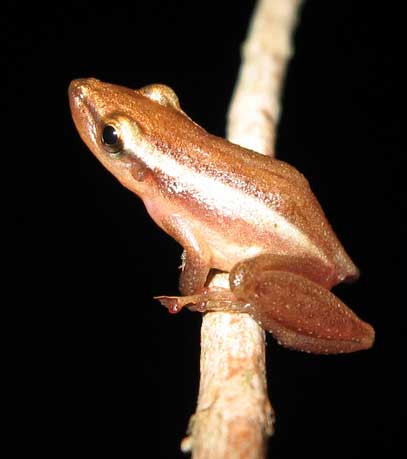
Scinax squalirostris (*)
Superregnum: Eukaryota
Regnum: Animalia
Subregnum: Eumetazoa
Cladus: Bilateria
Cladus: Nephrozoa
Superphylum: Deuterostomia
Phylum: Chordata
Cladus: Craniata
Subphylum: Vertebrata
Infraphylum: Gnathostomata
Superclassis: Tetrapoda
Classis: Amphibia
Subclassis: Lissamphibia
Ordo: Anura
Familia: Hylidae
Subfamilia: Scinaxinae
Genus: Scinax
Species: Scinax squalirostris
Name
Scinax squalirostris (Lutz, 1925)
Type locality: "Fazenda do Bonito, Serra da Bocaina, São José do Barreiro, São Paulo", Brazil.
Syntypes: AL-MNRJ 954-955 and USNM 96719-20.
Synonyms
Hyla squalirostris Lutz, 1925
Hyla lindneri Müller and Hellmich, 1936
Hyla evelynae Schmidt, 1944
Hyla evelinae — Cei and Pierotti, 1957
Hyla squalirostris evelynae — Klappenbach in Klappenbach and Orejas-Miranda, 1969
Ololygon squalirostris — Fouquette and Delahoussaye, 1977
Scinax squalirostris — Duellman and Wiens, 1992
References
Lutz, 1925, C. R. Seances Soc. Biol., Paris, 93: 212.
Duellman and Wiens, 1992, Occas. Pap. Mus. Nat. Hist. Univ. Kansas, 151: 23.
Frost, D.R. 2021. Amphibian Species of the World: an Online Reference. Version 6.1. Electronic Database accessible at https://amphibiansoftheworld.amnh.org/index.php. American Museum of Natural History, New York, USA. DOI: 10.5531/db.vz.0001 Scinax squalirostris . Accessed on 17 Apr 2008.
2007 IUCN Red List of Threatened Species IUCN: Scinax squalirostris (Least Concern) Downloaded on 17 April 2008.
Vernacular names
English: Striped Snouted Treefrog
Scinax squalirostris is a species of frog in the family Hylidae. It is found in southeastern, southern and central Brazil, Uruguay, northeastern Argentina, southern Paraguay, and Bolivia. The nominal species might actually represent more than one species.[1][2] Common names striped snouted treefrog and long-snouted treefrog have been coined for it.[2]
Scinax squalirostris from above.
Scinax squalirostris perched on a leaf.
Description
Scinax squalirostris is a small species measuring 24–29 mm (0.94–1.14 in) in snout–vent length. The overall appearance is slender; the limbs are slender and the hind limbs are fairly long. The head is long and wider than the body. The snout is very elongated. The tympanum is distinct. The dorsal ground color is brownish. There is a narrow, black mid-dorsal line and black canthal lines bordered with white. Two black stripes start from the eye and enclose a white or flesh-colored area. The belly is greenish yellow. The vocal sac is large and lemon-colored.[3]
Habitat and conservation
Scinax squalirostris occurs in open areas of grasslands, rushes, and Eryngium spp., but also in forests, at elevations below 1,500 m (4,900 ft). Breeding takes place in small permanent and temporary waterbodies, including cattle ponds.[1]
Scinax squalirostris is a common species that adapts well to anthropogenic disturbance. Pollution might be a localized threat. It is known from several protected areas in Brazil and Argentina.[1]
References
Lucy Aquino, Axel Kwet, Débora Silvano, Esteban Lavilla, Diego Baldo (2010). "Scinax squalirostris". IUCN Red List of Threatened Species. 2010: e.T55996A11396483. doi:10.2305/IUCN.UK.2010-2.RLTS.T55996A11396483.en. Retrieved 17 November 2021.
Frost, Darrel R. (2017). "Scinax squalirostris (Lutz, 1925)". Amphibian Species of the World: an Online Reference. Version 6.0. American Museum of Natural History. Retrieved 10 December 2017.
Lutz, B. (1973). Brazilian Species of Hyla. Austin: University of Texas Press. pp. 122–123. ISBN 978-0292707047.
Retrieved from "http://en.wikipedia.org/"
All text is available under the terms of the GNU Free Documentation License

